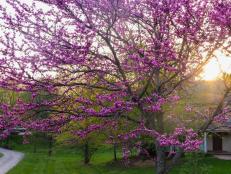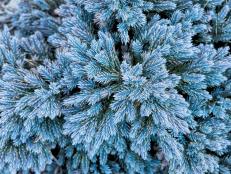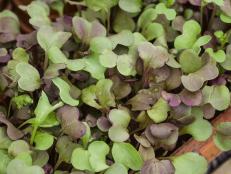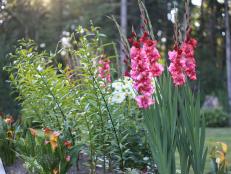How to Plant and Grow a Mulberry Tree
Learn all about sometimes-controversial mulberry trees, plus get expert tips and information for choosing, planting, growing and caring for mulberries in your home landscape.

Love it or hate it, the extremely adaptable mulberry tree can handle the toughest gardening conditions. Mulberries thrive in environments where other trees struggle to survive. This versatile tree will perform well in salty ocean spray, hot and dry summers, poor soil, sun and shade. Mulberries come in many shapes and forms, including dwarf, weeping, fruitless and high-quality fruiting varieties.

Shutterstock/Malivan Iuliia
Mulberry trees make a striking addition to this landscape design filled with color.
Botanical Name: Morus spp.
Common Name: Mulberry
Light Needs: Full sun to light shade
Hardiness Zones: (4)5 to 8(9)
Height & Width: Up to 50’ tall with an equal spread, although smaller varieties are available
Growth Rate: Fast
The three prevalent species of mulberry in North America are the native red mulberry (Morus rubra), the introduced black mulberry (Morus nigra), and the frequently problematic and even invasive white mulberry (Morus alba). All three species are somewhat similar in terms of habit, height, flower and fruit quality, with cultivated varieties available for form, foliage and fruit (or lack thereof).
Mulberry trees may produce only male or female flowers on one plant, or both flower types may be present on one tree. In June through July, trees will produce a heavy crop of white, red, purple or black fruit that resemble long, thin blackberries. Fully-ripe fruits will easily separate from the tree. To speed up the mulberry harvest, lay a clean tarp on the ground below and give the branch a gentle shake. These sweet and flavorful fruits are delicious fresh, dried, juiced or in preserves.
Birds love mulberry fruits, which is a good and bad thing. Mulberries are an important source of food for many species of birds. Unfortunately, mulberry-laden fruit droppings can discolor and even permanently stain pavement and patios below. Mulberry seeds can survive a trip through a bird’s digestive tract, which means that hungry birds can also spread non-native mulberry species. This is especially an issue in the many states where white mulberry is classified as an invasive plant. Look for fruitless varieties to limit the spread of invasive species and eliminate messy bird droppings.
Leaf Shape
All mulberry species have polymorphic leaves that can vary dramatically in size and shape — even across the same tree. In sunny conditions, mulberry leaves are often mitten or fig shaped and deeply lobed, while in the shade foliage tends to be much larger and more rounded, taking on an elongated heart shape. These are both adaptive responses to help mulberries thrive. Lobed leaves are more efficient at conserving water, and large rounded leaves are better able to capture sunlight through the canopy.
Species
Red mulberry (Morus rubra) has an extensive native range from north in Massachusetts, south to Florida and Texas, and west to Nebraska. Red mulberry is naturally found growing in rich woods and along riverbanks and bottomlands. For best results, plant this species in moist, well-drained soil with plenty of organic matter. The sweet summer fruits are relished by humans and birds alike. Given the right conditions, red mulberry can even produce fantastic golden fall color. It’s tricky to distinguish red from white mulberry plants, especially because they hybridize in the wild. Although these species have similar shaped leaves, red mulberry leaves won’t be smooth and glossy like white mulberries.
Black mulberry (M. nigra) is native to Western Asia. Its large, delicious fruits quickly made it a popular selection when it was introduced to European countries in the 1500s. Although this species has escaped cultivation and caused disturbance in native habitats in other areas of the world, it is not currently classified as an invasive species in most areas of the United States.
White mulberry (M. alba) has been grown in North America since colonial times when it was imported from China as fodder for silkworms. Although silk production failed, white mulberry thrived. This species has become naturalized throughout much of the continent. As this robust and adaptable species established itself in the wild, it displaced many other native species, including red mulberry. Today, there are many fruitless and highly ornamental varieties available in myriad forms, which means that it is possible to grow white mulberry without worrying as much about its impact beyond the garden walls.
How to Use Mulberry in Your Landscape
Mulberries can be grown for shade, fruit or as a statement tree. Ornamental white mulberries tolerate a wide range of conditions including pollution, salt spray, full sun, light shade, extreme heat, infertile soils and even some drought. If you choose a fruiting variety (or if you’re unsure whether it will produce fruit), site mulberry well away from pavement, patio furniture and laundry lines. Large, established trees may lift sidewalks, driveways and patios, so be sure to give roots plenty of room to grow.
How to Plant Mulberry
Mulberries are extremely adaptable and will tolerate full sun to light shade and most soil types. These tough trees grow well from seed, rooted cuttings, and nursery-grown container plants. For best results, plant out in cool spring or fall weather. Water every few days during the first season, then as needed once the roots are established.
In gardens with intense wind, stake young trees during the first season. Use rubber strapping instead of wire or rope to secure the tree to the stake. Wide rubber straps will grow along with the branch and shouldn’t damage bark. Regardless of the staking system used, it’s important to remove stakes and straps as soon as the tree is established.
Mulberry Care
Mulberries are generally tough, carefree trees that need little care after the first season. Although mature mulberries can handle some drought conditions, trees grown in hot, dry areas with sandy soils will perform better with regular water and fertilizer.
Pruning
Mulberries naturally produce a congested crown full of thin, crossing branches that give these trees a reputation of being messy and unkempt. Plan on annual pruning to achieve a healthy habit with a strong shape. Mulberry’s milky sap can irritate some folks’ skin, so be sure to wear gloves and long sleeves for protection while working on this tree.
Use hand pruners to trim out slender branches that are one-half inch or smaller in diameter. Loppers come in handy for cutting out branches that are up to 3 inches in diameter. Use a hand saw to remove larger branches. When using a hand saw, begin with an undercut below the limb to prevent the bark from tearing and damaging the tree.
Follow the branch back to where it sprouts out from the trunk or larger limb and remove it at the base. Don’t leave a stub behind. Dormant buds on mulberry stubs may sprout, making the crown even more congested than it was before pruning.
Health Problems
According to Michael Dirr’s Manual of Woody Landscape Trees, mulberries are susceptible to many insect pests and disease problems including leaf spot, bacterial blight, cankers, powdery mildew, scale insects and two-spotted spider mites. If your mulberry tree seems to be struggling, call your local county extension office to correctly identify the problem and find a solution.
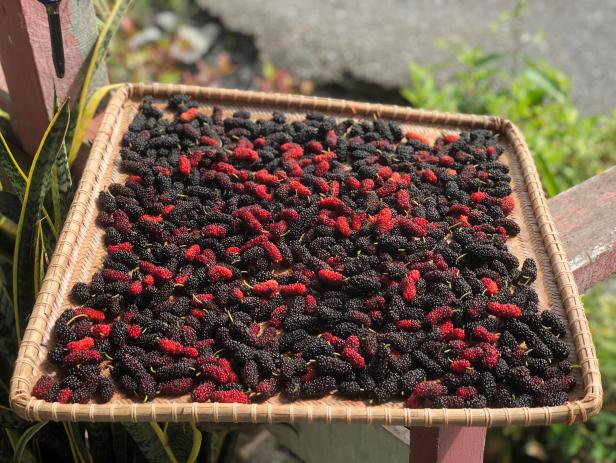
Shutterstock/wms5637
Fruiting varieties of mulberry produce loads of blackberry-like fruit that birds love as much as humans do.
Popular Mulberry Varieties
Fruitless Mulberries
- M. alba ‘Fruitless’ – deeply lobed, glossy green leaves
- M. alba ‘Kingan’ – a fast-growing tree that produces lustrous leathery leaves and has excellent salt tolerance
Dwarf Mulberries
- M. alba ‘Fegyvernekiana’ – very bushy and compact selection that will grow to 4 feet in height; fruitless
- M. rubra ‘Super Dwarf’ – a slow growing variety of the native mulberry; diminutive 3-foot-tall bushes are densely covered with adorable tiny, deeply lobed leaves
Weeping Mulberries
- M. alba ‘Chaparral’ – excellent weeping habit on a compact 8-foot-tall tree; attractive bright green foliage; fruitless
- M. alba ‘Urbana’ – very attractive imposing, gnarled weeping habit; about 20’ high with similar spread; fruitless
Fruiting Mulberries
- M. rubra – there are some superior fruiting varieties of this species (including ‘Hick’s Everbearing’, ‘Johnson’, and ‘Travis’) that are difficult to find commercially; however, the straight species of this native mulberry produces a plentiful crop of delicious fruits
- M. nigra ‘Black Beauty’ – especially large fruits are easier to reach on this 15-foot-tall variety
- M. nigra ‘Wellington’ – a large, 30-foot tree that produces delicious, high quality fruit; good cold-hardiness

.-Battle-on-the-Beach-courtesy-of-HGTV.-.jpg.rend.hgtvcom.196.196.suffix/1714761529029.jpeg)




